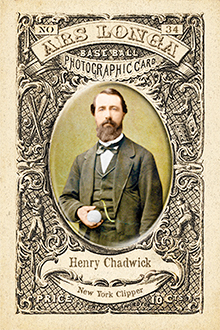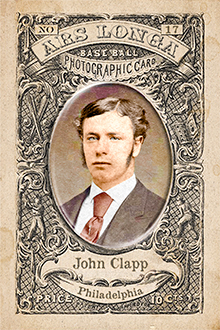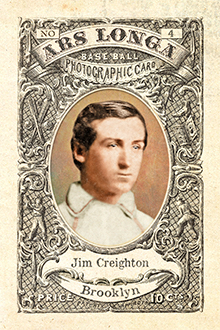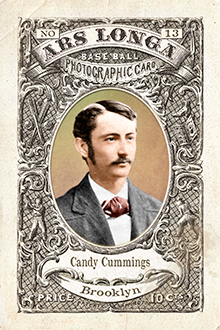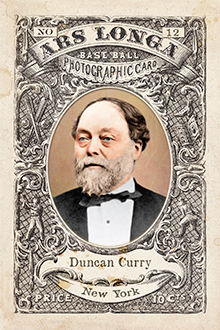- Series: Pioneer Portraits I: 1850-1874
- City: New York
- Team: Knickerbockers
- Hall: National Baseball Hall of Fame
Alexander Joy Cartwright (1820-1892) was declared the inventor of baseball by an act of Congress in 1953. A founding member of the Knickerbocker Base Ball Club in 1842, Cartwright is oftentimes falsely credited with establishing the 9 player “diamond” format in 1845. Modern researchers have largely debunked the historical import of Cartwright’s influence upon the game, its rules and development during those early formative stages, citing a propagandizing campaign by Cartwright’s son as a primary source of myth-making.
- The Knickerbocker rules form the foundation of the modern game
- Thanks to such rules, runners are no longer “tagged out” via thrown balls
- The diamond’s dimensions were termed by Red Smith “the closest man has ever come to perfection.”
- Elected to Hall of Fame: 1938

- Series: Pioneer Portraits I: 1850-1874
- City: Philadelphia
- Team: Pythian B.B.C.
- League: National Colored Baseball League
Octavius Valentine Catto (1839-1871) died a martyr for civil rights in Philadelphia amid violent Reconstruction Era political strife when he was shot three times and killed while on his way to vote. Only a few years before, he had been a pioneer in the early days of baseball as founder of the Pythian Base Ball Club in 1867. The emerging national game was shedding its elitist roots of pre-Civil War days and Catto was trying to make it a truly all-American sport. He sought membership for his club in the National Association and, in 1869, organized the first inter-racial match in Philadelphia versus the Olympic Ball Club. Catto had dedicated his life to the pursuit of freedom. He was an educator and mentor of black men, a military leader during the war, and ended his life in the forefront of the political struggle, including the integration of Philadelphia’s transit system. He brought to baseball the same passionate devotion that characterized his all-too-short life.
- The “gentlemen’s agreement” adopted by white baseball executives in response to Catto’s bid held sway – with very few exceptions – until 1947 when another talented infielder finally broke the color barrier
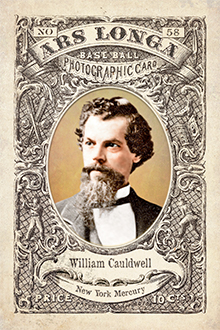
- Series: Pioneer Portraits I: 1850-1874
- City: New York
William Pierce Cauldwell (1824-1907) was, per the New York Tribune’s obituary, “the father of Sunday journalism.” More significantly for baseball, Cauldwell was the first publisher to dedicate regular space and ink to the game of baseball as news (starting in 1853), while also serving as mentor to the “Father of Baseball,” Henry Chadwick, whom he hired in 1858 to report on the new “national pastime” - a phrase Cauldwell’s Sunday Mercury newspaper coined on December 5, 1856.
Cauldwell had begun as a typesetter in 1841 before becoming publisher of the Sunday Mercury in NYC. In 1853 he began covering the games between the Knickerbockers and Gothams, introducing a wide audience to this phenomenon of outdoor athletics. He charted its course, reporting on the exponential growth of clubs all over the country. In his summary of the game in 1860, Cauldwell’s column no longer was long enough to list all the teams. He noted that California had seen its first game played on Feb 22 of that year.
- Cauldwell was active in politics, serving in the NY Senate and State Assembly as well as being a Supervisor of The Bronx before its annexation into NY City
- Series: Pioneer Portraits I: 1850-1874
- City: New York
- Hall: National Baseball Hall of Fame
Henry Chadwick (1824-1908) is widely considered the “Father of Baseball” due to his profound influence on early public awareness of the game and upon its foundational rules. A journalist from Brooklyn, Chadwick was present at the creation as he saw the new game developing in the 1860s and began what would become sports reporting today.
- Literally wrote the book on baseball: Beadle’s Dime Base Ball Player in 1860
- Edited Spalding’s Official Base Ball Guide for decades
- Saw to it we don’t have tie games or one-bounce outfield put-outs today
- Elected to Hall of Fame: 1938
- Series: Pioneer Portraits I: 1850-1874
- City: Philadelphia
- Team: Athletics (NABBP)
- League: National Association (NAPBBP)
John Edgar Clapp (1851-1904) played for 8 teams and managed 6 over a 12 year span, beginning in the National Association with the Middletown Mansfields in 1872 and ending with the NY Gothams in ’83. Primarily a catcher, Clapp had a career BA of .283. With a lifetime 2,523 ABs, he struck out only 51 times.
- Was the first player-manager in major league history (1872)
- Jay Jaffe's JAWS system ranks John as the 88th best catcher in MLB history, just after Bubbles Hargrave and before Ed McFarland
- Earned the nickname “Honest John” after reporting a bookie’s attempted bribe to local police
- The 1881 bribe, in current dollars, amounted to @$119,000
- Fittingly, this Honest John entered police work after retirement from the game and died on the job in his hometown of Ithaca, NY
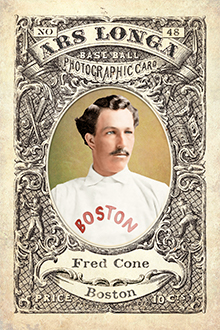
- Series: Pioneer Portraits I: 1850-1874
- City: Boston
- Team: Red Stockings (NAPBBP)
- League: National Association (NAPBBP)
Joseph Frederick Cone (1848-1909) played professionally for the Boston Red Stockings of the old National Association in 1871 and, at age 30, one season with the minor-league New Bedford/New Haven/Hartford club in the International Association. The Bostons were among the elite of their day with George and Harry Wright, and a young Al Spalding on the mound. In his latter stint, Fred played with many who would go on to major-league careers of note. Among them: Billy Barnie, Roger Connor, Jim Mutrie, and Harry Stovey. Such was the opportunity that lay before young ballplayers of that era. The game was rapidly establishing itself in the nation’s consciousness. History was being made and traditions were being formed.
- Cone batted .260 in his major-league campaign. In between his time in Boston and Connecticut, Fred was an umpire for two seasons: 1875 in the NA and 1877 in the NL
- Played amateur ball for the Rockford Forest Citys in 1868-69 before following teammates Spalding and Ross Barnes to Boston
- Rockford may have been the first to pay players, at least for their “practice” time
- Series: Pioneer Portraits I: 1850-1874
- City: Brooklyn
- Team: Excelsiors
- League: National Association (NABBP)
James Creighton, Jr. (1841-1862) was a star pitcher for the Excelsior of Brooklyn from 1860-62. Widely regarded as the game’s 1st superstar and, perhaps, its 1st martyr. His unique pitching motion propelled him to fame, but his death from a ruptured hernia caused while hitting a home run gave this young man a place in the Pantheon of early greats.
- John Thorn, official historian of MLB, has called Creighton the “most important player not inducted into the Hall of Fame”
- Threw baseball’s 1st shutout: 11.8.1860
- In 1866 baseball made a small contribution to national reconciliation as the Washington Nationals came to Brooklyn for a match. Both clubs retired to the Creighton monument where, per the NY Times, “a silent tear was dropped to [his] memory…”
- Series: Pioneer Portraits I: 1850-1874
- City: Brooklyn
- Team: Star of Brooklyn
- League: National Association (NABBP)
- Hall: National Baseball Hall of Fame
William Arthur Cummings (1848-1924) has a plaque in Cooperstown today, not because of his won-lost record or ERA – both of which were excellent; but primarily because he is credited with inventing the curveball, and was able to throw it effectively under the combat conditions of early baseball. A star for the Brooklyn clubs in the old NABBP in the 1860s, Cummings continued to be effective in the pro era until 1877.
- Cummings got the idea for the curve from a day at the beach chucking clam shells
- Once catcher Nat Hicks moved close behind the batter, the curve became a viable pitch
- Elected to Hall of Fame: 1939
- Series: Pioneer Portraits I: 1850-1874
- City: New York
- Team: Knickerbockers
Duncan Curry (1812-1894) is one of a group of illustrious founders of the Grand Old Game. Several have been put forward as the true “Father of Baseball” and Curry’s claim is as sturdy as any. A founder of the Knickerbocker Club (a requisite for paternity), Curry was an integral part of the beginnings of the game, including participation in the “first” game: in Hoboken NJ June 19, 1846.
- The NJ interlopers destroyed the Knickerbockers in that game 23-1
- Curry blamed the loss on overconfidence and an opposing pitcher with blinding speed
- In 1856 Curry’s preferred seven-inning format lost out to Louis Wadsworth’s nine, signaling the transition of the game’s growth out of the hands of the founding Knickerbockers



